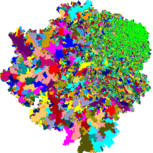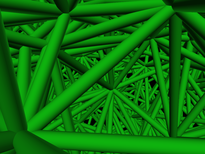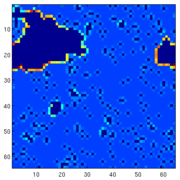Physics of Complex Systems and Advanced Materials
 |
Fragmentation phenomenaFragmentation, i.e. the breaking of particulate materials into a large number of smaller pieces is abundant in nature and underlies several industrial processes. Fragmentation phenomena can be observed on a broad range of length scales from the collisional evolution of asteroids and meteor impacts on the astrophysical scale, through geological phenomena and industrial applications on the intermediate scale down to the break-up of large molecules and heavy nuclei on the atomic scale.. More details ... |
Fragmentation, i.e. the breaking of particulate materials into a large number of smaller pieces is
abundant in nature and underlies several industrial processes, which attracted a continuous interest in scientific research over the past decades. Fragmentation phenomena can be observed on a broad range of length scales
from the collisional evolution of asteroids and meteor impacts on the astrophysical scale, through geological phenomena and industrial applications on the intermediate scale down to the break-up of large molecules and
heavy nuclei on the atomic scale. The most striking observation on fragmentation is that the distribution of fragment sizes or masses shows a power law behavior, independently on the way of imparting energy,
relevant microscopic interactions and length scales involved, with an exponent depending only on the dimensionality of the system. The understanding of this observed universality of fragmentation phenomena is till today
the main driving force of theoretical studies. Besides one-, two-, and three-dimensional bulk materials, shell-like structures are also widely used in everyday life and industrial applications: they are used in the form of
containers, pressure vessels, combustion chambers, airplane pressure chambers. Sudden excessive pressure pulses arising due to an explosion inside closed shells can result in substantial damage and even complete
destruction of the structure. From theoretical point of view the fragmentation of shell-like system is a very interesting and challenging problem because locally shells are two-dimensional objects; however, their dynamics
occurs in three dimensions giving rise to novel types of breaking mechanisms affecting also the final state distribution of characteristic quantities.
|
|
Statistical physics of fracture and related problemsFragmentation, i.e. the breaking of particulate materials into a large number of smaller pieces is abundant in nature and underlies several industrial processes. Fragmentation phenomena can be observed on a broad range of length scales from the collisional evolution of asteroids and meteor impacts on the astrophysical scale, through geological phenomena and industrial applications on the intermediate scale down to the break-up of large molecules and heavy nuclei on the atomic scale.. More details ... |
 |
The mechanical response and fracture of materials is traditionally the subject of engineering sciences. However, the
experimental and theoretical findings on the existence of scaling behavior have demonstrated that the fracture of disordered materials exhibits a high degree of analogy to phase transitions and critical phenomena, so that
a comprehensive understanding can only be obtained in the framework of statistical physics. Due to the dominating role of disorder, the theoretical description of the fracture of heterogeneous materials requires the
application of novel methods of computer modeling, computational physics and materials science as well. During the last decade at the border line of physics, materials science and engineering sciences a new field of
science emerged, namely, the statistical physics of fracture, which have already achieved several novel results with technological importance. Natural catastrophes like earthquakes, snow and rock avalanches,
landslides are often caused by crack nucleation under shear load and by the stick-slip motion of compressed crack surfaces. The investigation of fracture phenomena helps to understand the emergence of natural catastrophes
revealing relations of observables as well which can be exploited for the forecasting of catastrophic failures.
|
|
 |
Rheological FluidsElectro- and magnetorheological fluids, also called smart fluids, are colloidal materials composed of micrometer sized particles suspended in an electromagnetically passive viscous liquid. The most striking feature of ER and MR fluids is that their reological properties can be controlled by an external electric or magnetic field which has major potential in automotive, and aircraft/aerospace applications. They can be used in devices such as dampers, shock absorbers, brakes, clutches, valves, position and speed controllers. Our work is focused on magnetorheological systems where the particles have a permanent magnetic dipole moment. In such colloids in the absence of an external magnetic field the particles aggregate due to the dipolar interaction and biuld up complex structures which gives rise the change of the overall rheological properties of the colloid. More details ... |
Hamarosan .. 3 |
|
Socio-economic systemsRecently, the application of statistical physics and of the theory of critical phenomena provided novel insight into the dynamics of socio-economic systems. Various types of models have been developed which capture important aspects of the emergence of communities, opinion spreading or the evolution of financial data. The dynamics of innovation and the spreading of new technological achievements show also interesting analogies to complex physical systems. More details ... |
 |
The process of innovation has recently been studied
by introducing a
technology space based on percolation theory \cite{silverberg}. In
this model new inventions arise as a result of a random search in the
technology space starting from the current best-practice
frontier. The model could
reproduce the interesting observation that innovations occur in
clusters whose sizes are described by the Pareto distribution.
Another important aspect of technological
development is the spreading of new technological achievements.
In a socio-economic system
different level technologies may coexist and compete as a result of
which certain technologies proliferate while others disappear from
the system. One of the key components of the spreading of successful
technologies is the copying, i.e. members of the system adopt
technologies used by other individuals according to certain decision
mechanisms. Decision making is usually based on a cost-benefit balance
so that a technology gets adopted by a large number of individuals if
the upgrading provides enough benefits. The gradual adaptation of high
level technologies leads to spreading of technologies and an overall
technological progress of the socio-economic system.
In our work we consider a simple agent-based model of the
spreading of technological achievements in socio-economic
systems. Agents of the model may represent individuals or firms which
use certain
technologies to collaborate with each other. For simplicity, we assume
that costs of the cooperation arise solely due to the incompatibility
of technologies used by the agents which then have two origins: on the
one hand, difference of technological levels incurs cost, the larger
the difference is, the higher the cost gets. On the other hand,
technologies used by agents may belong to different providers which
induce additional costs. Agents interacting with their social
neighborhood can decrease their cost by adopting technologies of their
interacting partners. The local rejection-adaptation strategy of
agents can lead to interesting changes of the system on the meso- and
macro-level, namely, agents can form clusters with identical
technological levels, which can also be accompanied by an overall
technological progress of the system.
We analyze the time evolution of this model
socio-economic system starting from a random configuration of
technological levels and providers without considering the possibility of
innovation. Based on analytic calculations and computer simulations we
study how the adaptation of technologies of interacting partners leads
to spreading of technological achievements. We characterize the
microstructure of communities of agents, and the technological
progress of the system on the macro level.
|
|
 |
LatestMore details ... |
Hamarosan ... 5 |
|
News

Science on our PNAS paper
Our paper as Editors' Suggestion
Our paper as Editors' Suggestion
Index on our work
Paper in Scientific Reports
New paper in PRL
Highlighted in Physics Focus
Associate Editor of Frontiers in Physics
Radio interview on our work
Index on our research
On the cover of PRL
Research Highlights





